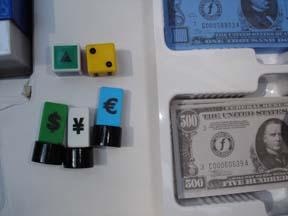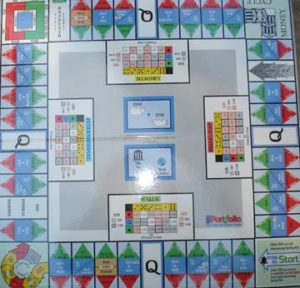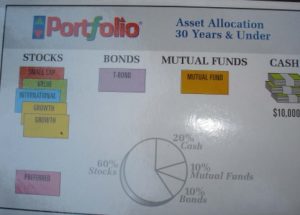Investment Board Game Review – Portfolio – the Asset Allocation Game
Want to learn the ropes and lingo used in the stock market?
Portfolio – the Asset Allocation Game is a game that will help.This Weskel game was developed over a 5 year period from 1998 to 2003 by it’s inventor, a Dad and teacher, who wanted to learn more about the market and it’s lingo in a fun way. In 2001, it was played by close friends of the inventor for the first time, then tested on different focus groups.
Portfolio game description.
Contents include a game board, 8 asset allocation cards, a set of bulls & bears question cards, a set of The Fed/World question cards, a set of securities, a regular dice and a dice to indicate the direction of the market (up down or neutral).

Game Pieces
There are 8 game pieces, each marked with one country’s currency symbol and a rule sheet. In addition there is play money in denominations of $100, $500 and $1000. All parts of the game are heavy duty, quality construction.

Portfolio game board
The object of the game is to be the first player to fill out your asset allocation card with the listed securities and cash. Alternatively, you can set a time limit then count up who has the most value in their portfolio and cash at the end of the time and declare that person the winner.
The game can be played at three levels, basic play, advanced options and just questions.
How to play Portfolio.
The game is for ages 12 to adult and up to 8 players can play. Each player selects an asset allocation card, and a currency game piece. The available asset allocation cards cover ages 30 & under; ages 30 – 45; and ages 45 – 55 with each having a different mix of securities required to win. All however are composed of some percentage of stocks (small cap, value, international, growth and preferred), bonds (T-bonds, agency bonds, T-notes, muni bonds and corporate bonds).
 A person is designated as banker – who gives each player $5000 to start and then manages the bank money. Another person is designated to manage the securities cards (giving them out when players buy them and taking them back when they are lost).
A person is designated as banker – who gives each player $5000 to start and then manages the bank money. Another person is designated to manage the securities cards (giving them out when players buy them and taking them back when they are lost).

Inside the box
Players start at the Start square (and get $500 for each preferred stock and bond they own when passing the space, as well as a $500 gift. Both dice are rolled and the player moves around the squares the rolled number of times, then uses the market indicator die to figure out where on the square the player has landed (market up, market down or in the middle).
Players may buy and sell securities from the market (aka the designated securities card manager) or from each other.
Players must have $2000 on hand at all times, and can’t own more than 10 securities at a time.
Players can get more cash by landing on a question space, then picking a question prize amount ($100, $200, $500 or $1000). The more a question is worth, the harder it is. If you answer the question correctly, you get the cash amount you picked. Many questions are multiple choice.
There are questions about the market such as these:
- $100 What is the stock symbol for Dun & Bradstreet? (DNB or NKE).
- $200 What do you call the large pools of money collected by sophisticated investors willing to invest in companies needing cash? (Venture capital or mother lode).
- $500 What is the risk to short selling a stock? (It could go down or up in value).
- $1000 In what sector and industry is Delta Air Lines?
Answers: (DNB, Venture capital, It could go up in value, Transportation/Airlines).
Here is a sample question from World Economics:
- $100 What company first became Earth’s biggest on-line bookstore and is rapidly becoming Earth’s biggest anything-for-sale store? (Amazon.com or Nations Bank).
- $200 What market crash suffered a greater percentage loss (1929 or 1987)?
- $500 What goal do governments hope to achieve for their currency, sometimes buying their own currency to achieve this goal? (Stable or unstable value).
- $1000 What are LEAPS?
Answers: (Amazon, 1987, Stable, Long term options)
Below is a sample question from The Fed:
- $100 Who is a top competitor of Darden Restaurants, leading dining restaurant operator, home to The Olive Garden and Red Lobster? (Caterpillar or Landry’s Restaurants).
- $200 What did the stock market do at the outbreak of the American Civil War in 1861? (Drop or climb).
- $500 At what two facilities does the Bureau of Engraving and Printing print paper money? (Chicago $ Denver or Washington, D.C. & Fort Worth).
- $1000 How many types of bonds does the U.S. Treasury offer that can be sold in the secondary market? (Three or fourteen).
Answers: (Landry’s Restaurants, Drop, Washington D.C. And Fort Worth, TX, Three).
What Portfolio can teach you about the stock market and asset allocation.
- Composition of typical asset allocation models by age group.
- Market lingo.
- Detailed information about securities and economics through the questions.
- Risks involved in trading (price changes, inflation, market cycles, currency risk).
- That sometimes the market works in seemingly random ways.
- Re-balancing of your allocation model is needed.
My take on Portfolio – the Asset Allocation Game.
There is a lot to absorb when you first start playing and play can take quite awhile. However, after two or three times playing, it is a good game for the recommended ages. I intend to start introducing my grandchildren to this game when they are between 10 and 11 to see how they do with it then, but that is a few years off. Meanwhile we will play it with the adult family members!
You will definitely learn some market facts – especially with the questions, most of which I found adequately challenging.
I bought it, I play it!
Have you ever played Portfolio? If so, how did you like it? What other games and tools are out there to teach folks about the market?



